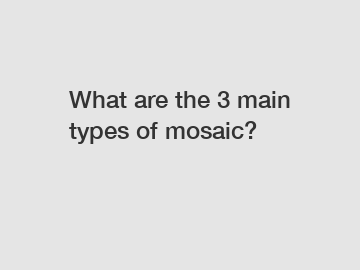What are the 3 main types of mosaic?
What are the 3 main types of mosaic?
Mosaic art dates back to ancient times and has been an integral part of various cultures throughout history. This timeless art form involves creating images or patterns by arranging small pieces of glass, ceramic, stone, or other materials. Mosaics can be found in architectural structures, religious buildings, and even in humble home decor. With such a rich and diverse art form, it is natural to wonder about the different types of mosaics. So, let's dive into the three main types of mosaics that have captivated audiences for centuries.
1. Classical Mosaic:

The first type of mosaic is the classical or traditional mosaic. Originating in Ancient Greece and Rome, classical mosaics were often used to depict scenes from mythology, gods and goddesses, and historical events. These mosaics were created using small, individually cut and shaped pieces called tesserae. Made of stone, glass, or ceramics, the tesserae were carefully arranged to form intricate designs. Classical mosaics were known for their vibrant colors and meticulous craftsmanship. The art form reached its peak during the Byzantine period when it adorned the walls and domes of magnificent structures such as the Hagia Sophia in Istanbul.
2. Byzantine Mosaic:
The second type of mosaic is the Byzantine mosaic. Building upon the techniques of classical mosaics, Byzantine mosaics took the art form to another level of grandeur. Byzantine mosaics often featured religious themes, depicting biblical scenes, saints, and angels. These mosaics were characterized by their extensive use of gold tesserae, which added a radiant glow to the artwork. One of the most famous examples of Byzantine mosaic art is found in the Church of San Vitale in Ravenna, Italy.
3. Modern Mosaic:
The third type of mosaic is the modern mosaic. As the name suggests, this type emerged during the 19th and 20th centuries and continues to evolve with contemporary artists pushing the boundaries of traditional mosaic techniques. Modern mosaics embrace innovation and experimentation, incorporating various materials such as metals, plastics, and even recycled items. Artists create vibrant and abstract designs, often exploring themes of nature, culture, and personal expression. Modern mosaics can be found both in public spaces and as individual art pieces, mesmerizing viewers with their imaginative designs and unconventional use of materials.
Despite the distinctions between these three main types of mosaics, it is important to note that there is often overlap and inspiration drawn from each other. Artists today may incorporate classical aesthetics into their modern works or revisit Byzantine techniques in contemporary religious art. Mosaic art is a testament to the enduring charm of blending tradition with innovation.
In conclusion, the world of mosaic art encompasses a wide range of styles and techniques. The classical, Byzantine, and modern mosaics each hold a unique place in the history and evolution of this captivating art form. From the mythological stories and historical events depicted in classical mosaics to the radiant glow of Byzantine masterpieces and the innovation and creativity of modern mosaics, the enduring allure of this ancient art form is unquestionable. So, the next time you come across a mosaic, take a moment to appreciate its intricate beauty and the rich heritage it represents.
Are you interested in learning more about Stylish Coconut Shell Tile Mosaic, inkjet swimming pool blue glass mosaic tiles, Mixed Hot Melt Glass Mosaic Tile? Contact us today to secure an expert consultation!

Comments